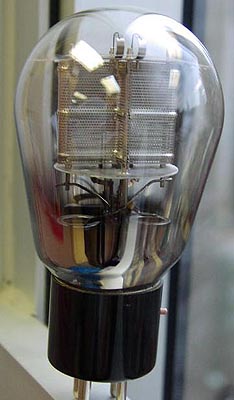 |
||||||||||||
| Sovtek 2A3/Phillips 5V4GA versus the TJ Mesh Plate 45/Phillips JAN 5Y3WGTA I'd had another HiFi journalist and Fi owner tell me that he thought the hot tube setup for the Fi 2A3 amplifiers were not 2A3 tubes at all, but rather the TJ mesh plate 45s combined with the 5Y3WGTA rectifiers. I was really curious to check out this combination and Brian Cherry of DIY Hi-fi supply was kind enough to supply a loaner pair of TJs for my review. |
||||||||||||
 |
||||||||||||
To compare the two tube combinations on equal footing, I again checked for output differentials and found that the TJ 45 combo needed to add one click on the Tom Evans Audio Design Vibe preamplifier volume control to match the sound pressure level of the Sovtek 2A3 setup. Having established that offset adjustment, I continued my listening sessions to see how the swap affected sound and music-playing ability. |
||||||||||||
| Ray Charles passed from this life at the age of 73 while I was doing my listening sessions. To reminisce, I played my favorite Ray album, the 1961 Ray Charles and Betty Carter [DCC Jazz GZS-1050]. With the TJ 45, this was a lush, warm and mellow recording of songs about love and romance, with a little humor thrown in for good measure. One of my favorites is "Baby, It's Cold Outside" where Ray progressively tries to romance Betty into staying a little longer in his bachelor pad, with "why don't you put some records on while I pour" causing Betty to decreasingly resist while Ray increasingly woos "maybe just a cigarette more." Horns and drums come in on the right side, horns sounding appropriately blatty, piano coming in on the left warm and reverberant. | ||||||||||||
 |
||||||||||||
Ray's and Betty's voices sounded rich with no trace of sibilance and the cymbal work was both delicate and detailed. You could hear little noises coming from the right channel that sounded like creaking chairs or perhaps Betty bumping the microphone. With the 2A3/ 5V4 combo, the album retained the general character but horns sounded a little less blatty and there was less articulation to the cymbal shimmer. The Sovtek was a little more dynamic but cast a lesser sense of space. The 2A3s emphasized the voices' lower registers a little more while minute recording noises became less obvious and center fill shrank. The music per se was awesome with both sets of tubes but I marginally preferred the TJ s to the Sovteks on this album. |
||||||||||||
| On Lucinda Williams' World Without Tears [Lost Highway 0881703552], the Sovteks gave a big and dreamy quality to the recording though Lucinda's voice became a little strident at times when she leaned into it. Bass was big and boomy and vocals had a slight edge. The harmonica coming into the left channel was some of the best I've heard, with a vibrancy that made my ears stand at attention. The drum work kept the rhythm churning and the hi-hat sounded like it should. The TJ created more space, better resolution of fine detail, slightly keener articulation, less stridency on vocal peaks and recovered low-level lead guitar work that was entirely absent with the Sovteks. Microdynamic nuances were better resolved but traded at the expense of macro dynamics. On this recording, the TJs were significantly better than the Sovteks, excelling in every way though everything shifted up to be slightly brighter through the upper midrange. | ||||||||||||
 |
||||||||||||
Musical involvement for the TJs was up a notch too which is saying something - the Sovteks are very good in this regard. These 45s provide a punchy and articulate bass but with less weight than the Sovteks - same extension, just not as much mass. My Take On Tube Differences If I were you, I'd give the TJ 45 mesh plates and 5Y3WGTA rectifiers a try. You can order the TJs directly from Brian Cherry at DIY HiFi Supply in Hong Kong and have them in a couple of days. I am not sure where you might find the 5Y3WGTA rectifiers. I looked around and didn't unearth any at the usual tube websites. Don Garber sent me the ones I have now from his personal stash so maybe you should check with Don and see if he can steer you in the right direction. |
||||||||||||
 |
||||||||||||
|
|
||||||||||||
|
Then there's the pride of owning true art. No one will ever mistake one of Don Garber's handmade Fi amplifiers for anything else. They make a unique visual statement in the world of audio. Loudspeaker manufacturer and Fi X integrated amplifier owner Terry Cain of Cain & Cain fame told me he thought of the Fi amplifiers as audio art and of Don as a national audio treasure for his Fi lineup. If you've seen Terry's speakers, you'd have to admit that Terry knows more than a little about handcrafted art as well. His speakers are gorgeous creations. So I 'd heard that Don was an artist as well as an audio luminary proper. Then it dawned on me: The Fi monos embody the period of art in the late 1800s known as the Arts & Crafts movement characterized by handcrafted art notable for its plain materials and unadorned surfaces which made a statement against the glitzy mass-produced crap of that day. I've always thought the Fi gear exudes a certain artistic kewlness factor due to its simplicity and design excellence. It would look completely at home with a classic set of McKinnon Mission style hand crafted furniture, for example. These amps are art, after all. |
||||||||||||
 |
||||||||||||
|
|
 |
|||||||||||
| has become with its bank-vault fascias, jewelry-like finishes and stratospheric prices; and artistic in its ability to plant a well-groomed boot into those exclusionary boy-toys' derrières in the area of sonic and music-making ability. In case you're wondering - a chromed chassis with gold accents isn't available at any price. |
||||||||||||
|
|
||||||||||||
 |
||||||||||||
 |
||||||||||||
 |
||||||||||||